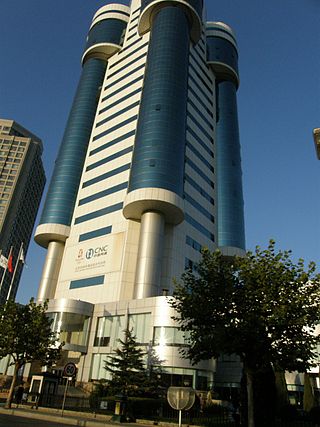Nepal's telecommunication network has increased over the years significantly, with the number of telephone users reaching 40,789,198 subscribers as of 14 May 2019.
The Universal Mobile Telecommunications System (UMTS) is a third generation mobile cellular system for networks based on the GSM standard. Developed and maintained by the 3GPP, UMTS is a component of the International Telecommunication Union IMT-2000 standard set and compares with the CDMA2000 standard set for networks based on the competing cdmaOne technology. UMTS uses wideband code-division multiple access (W-CDMA) radio access technology to offer greater spectral efficiency and bandwidth to mobile network operators.

3G is the third generation of wireless mobile telecommunications technology. It is the upgrade over 2G, 2.5G, GPRS and 2.75G Enhanced Data Rates for GSM Evolution networks, offering faster data transfer, and better voice quality. This network was superseded by 4G, and later on by 5G. This network is based on a set of standards used for mobile devices and mobile telecommunications use services and networks that comply with the International Mobile Telecommunications-2000 (IMT-2000) specifications by the International Telecommunication Union. 3G finds application in wireless voice telephony, mobile Internet access, fixed wireless Internet access, video calls and mobile TV.
2G is a short notation for second-generation cellular network, a group of technology standards employed for cellular networks. 2G was commercially launched on the GSM standard in Finland by Radiolinja in 1991. After 2G was launched, the previous mobile wireless network systems were retroactively dubbed 1G. While radio signals on 1G networks are analog, radio signals on 2G networks are digital, though both systems use digital signaling to connect cellular radio towers to the rest of the mobile network system. 2G was superseded by 3G technology.

China Netcom, full name China Netcom Group Corporation Limited, abbreviated CNC, was a telecommunication service provider in People's Republic of China. It was formed in August 1999 by the Chinese government to enable inward investments to build high speed Internet communications in the country.

China United Network Communications Group Co., Ltd. or China Unicom is a Chinese state-owned telecommunications operator. Started as a wireless paging and GSM mobile operator, it currently provides a range of services including mobile network, long-distance, local calling, data communication, Internet services, and IP telephony. China Unicom is the third-largest wireless carrier in China and the sixth largest mobile provider in the world as of 2022.
China Telecommunications Corporation, known as its trading name China Telecom, is a Chinese state-owned telecommunication company. It is the largest fixed-line service and the third largest mobile telecommunication provider in China. It has three listed companies: China Telecom Corporation Limited, China Communications Services Corporation Limited and Besttone Holding Co., Ltd..

KDDI Corporation is a Japanese telecommunications operator. It was established in 2000 through the merger of DDI, KDD (ケイディディ), and IDO. In 2001, it merged with a subsidiary named Au, which was formed through the merger of seven automotive and mobile phone companies from the DDI-Cellular Group. As of 2020, it is the second-largest mobile telecommunications provider in Japan in terms of the number of contracts, following NTT Docomo.

SK Telecom Co., Ltd., abbreviated as SKT is a South Korean wireless telecommunications operator and former film distributor and is part of the SK Group, one of the country's largest chaebols. It leads the local market with 50.5 percent share as of 2008. SK Telecom is the largest wireless carrier in South Korea, with 27.019 million subscribers as of Q4 2017.

Nepal Doorsanchar Company Ltd., popularly known as Nepal Telecom or NTC, is a state-owned telecommunications service provider in Nepal with 91.49% of the government share. The company was a monopoly until 2003 when the first private sector operator United Telecom Limited(UTL) started providing basic telephony services. The central office of Nepal Telecom is located at Bhadrakali Plaza, Kathmandu. It has branches, exchanges and other offices in 184 locations within the country.
The Personal Handy-phone System (PHS), also marketed as the Personal Communication Telephone (PCT) in Thailand, and the Personal Access System (PAS) and commercially branded as Xiaolingtong in Mainland China, was a mobile network system operating in the 1880–1930 MHz frequency band, used mainly in Japan, China, Taiwan, and some other Asian countries and regions.
The telecommunications industry in China is dominated by three state-run businesses: China Telecom, China Unicom and China Mobile. The three companies were formed by restructuring launched in May 2008, directed by the Ministry of Information Industry (MII), National Development and Reform Commission (NDRC) and the Minister of Finance. Since then, all three companies gained nationwide fixed-line and cellular mobile telecom licenses in China. In 2019, all three telecoms were issued 5G national licenses.

Taiwan Star Telecom Corporation Limited, doing business as T Star for short, formerly Vibo Telecom Inc., was a 3G mobile network operator in Taiwan.
Hutchison Asia Telecom Group or HAT, is a division of Hong Kong-based multinational conglomerate CK Hutchison Holdings. The division provides telecommunications services to several Asian countries. The division was formerly incorporated as Hutchison Telecommunications International Limited, known as Hutchison Telecom or HTIL in short. It was an offshore company in the Cayman Islands and a listed company in the Stock Exchange of Hong Kong. It operates GSM, 3G and 4G mobile telecommunications services in Indonesia, Sri Lanka and Vietnam under brands 3, Hutch and Vietnamobile.

Mahanagar Telephone Mauritius Limited (MTML) is a division of Mahanagar Telephone Nigam Limited which specialises in telecommunications and Internet services currently operational in Mauritius. MTML was founded in 2003 as a division of Mahanagar Telephone Nigam Limited (MTNL).

The Japanese mobile phone industry is one of the most advanced in the world. As of March, 2022 there were 199.99 million mobile contracts in Japan according to the Ministry of Internal Affairs and Communications. This is 158 percent of Japan's total population.

Mobile phone industry in Russia is an trade industry of cell phone devices and mobile network services in Russia. Since the collapse of the Soviet Union in the 1991 it had seen a great expansion over the last decades becoming one of the largest in the world. In terms of number of smartphone users, Russia is the 4th biggest smartphone market in the world sitting behind only China, India, and USA.
The mobile phone industry in South Korea consists of domestic network infrastructure provision and the production of consumer mobile handsets.
3G mobile telephony was relatively slow to be adopted globally. In some instances, 3G networks do not use the same radio frequencies as 2G so mobile operators must build entirely new networks and license entirely new frequencies, especially so to achieve high data transmission rates. Other delays were due to the expenses of upgrading transmission hardware, especially for UMTS, whose deployment required the replacement of most broadcast towers. Due to these issues and difficulties with deployment, many carriers delayed acquisition of these updated capabilities.












